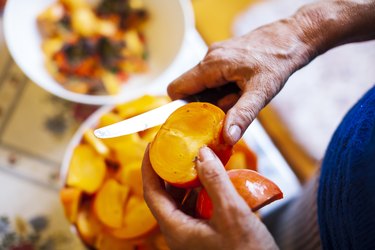
The two main types of persimmons are the native persimmon (Diospyros virginiana, USDA zones 4 to 9) and the Oriental persimmon (Diospyros kaki, USDA zones 7 to 10), with both producing edible fruit. However, persimmon fruit can be tough to recognize thanks to the large variety within its cultivars: some fruits appear round and small like an acorn, while others sprout completely flat or even square. They range in color from light yellow to dark red, tending to darken as they near ripeness.
Native Persimmon vs. Oriental Persimmon
Video of the Day
The native persimmon occurs naturally throughout Eastern and Midwestern areas of the United States and as the name infers, the Oriental persimmon's native range is throughout Asia. Native persimmons develop into larger trees, growing up to 60 feet tall and 35 feet wide, according to Missouri Botanical Garden. Whereas the Oriental persimmon tops out at 30 feet tall and wide. Both trees bloom in spring with male and female flowers usually appearing on separate trees but some trees contain both types.
Video of the Day
The ripe persimmon fruit of native types is around 2 inches in diameter and matures in fall. The green persimmons are very astringent until ripe when they turn very sweet. Ripe persimmons are orange to purplish-red. The ripe persimmons on Oriental types are 3 to 4 inches in diameter and ripen in fall. These are the bright orange persimmons found in the grocery store. They are non-astringent even when unripe and the fruit on both varieties can remain hanging on the tree into winter.. according to Missouri Botanical Garden.
Testing Persimmon Ripeness
Even though the fruits continue to ripen off the tree, you still want to harvest them when they are nearly ripe to ripe, especially if birds have zoned in on your crop. Many unripe persimmons like native types produce an astringent, bitter taste that will ruin your enjoyment of the fruit if harvested too soon. For the best flavor prolong harvesting as long as possible.
Persimmons tend to turn a dark red, purple or orange when nearing ripeness, depending on the variety. The fruit will also start to feel squishy or soft, while it is normally stiff or hard like an apple or orange. Many growers wait until after the first killing frost of the fall or winter to pick their persimmons, to ensure that the fruits are ready to ripen fully.
Harvesting and Ripening
If you want your persimmons to continue to ripen undamaged after you pull them from the tree, take the time to harvest them carefully. Do not simply yank the fruit from the tree as you can cause damage and it goes bad faster. Instead, snip off each persimmon being sure to retain the small stem attached to the top. The stems contain enough nutrients to help the persimmons continue to ripen even when disconnected from the tree.
If you want the persimmons to ripen quickly after harvest, there are a number of steps you can take to help it along its way. Store the fruit in a bag with an equal number of apples at room temperature to help them ripen. Similarly, freezing the fruits overnight and thawing them in the morning will help soften the fruit and remove some of the bitter taste associated with many types of non-ripe persimmons. Keeping persimmons in the refrigerator will stop them from decaying so fast, but will allow the fruits to continue softening.